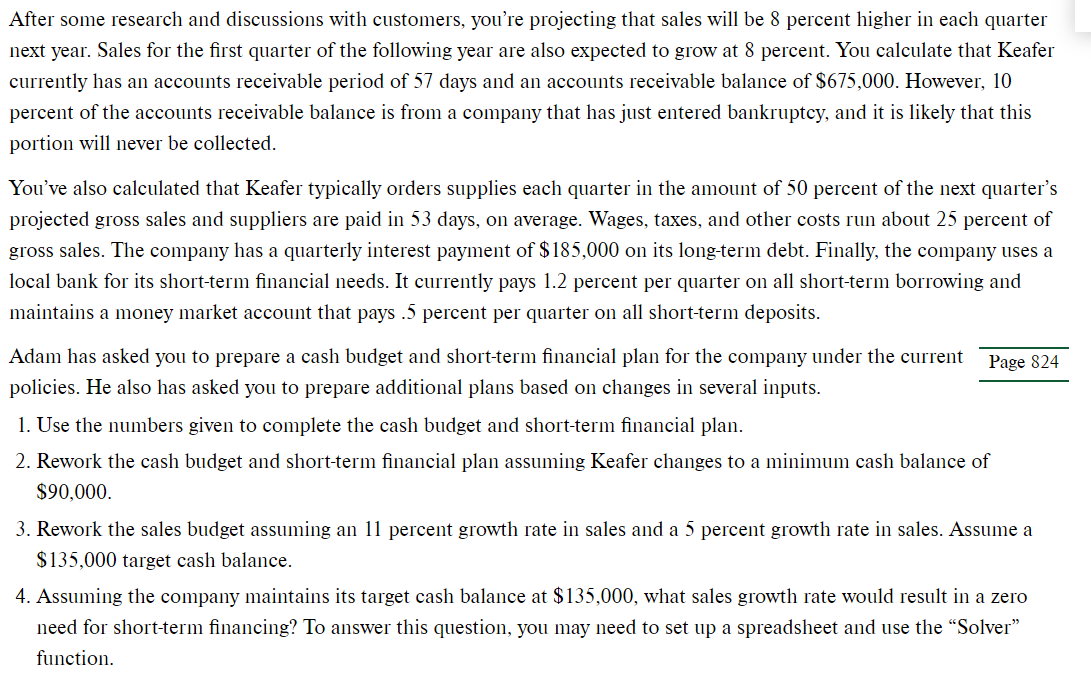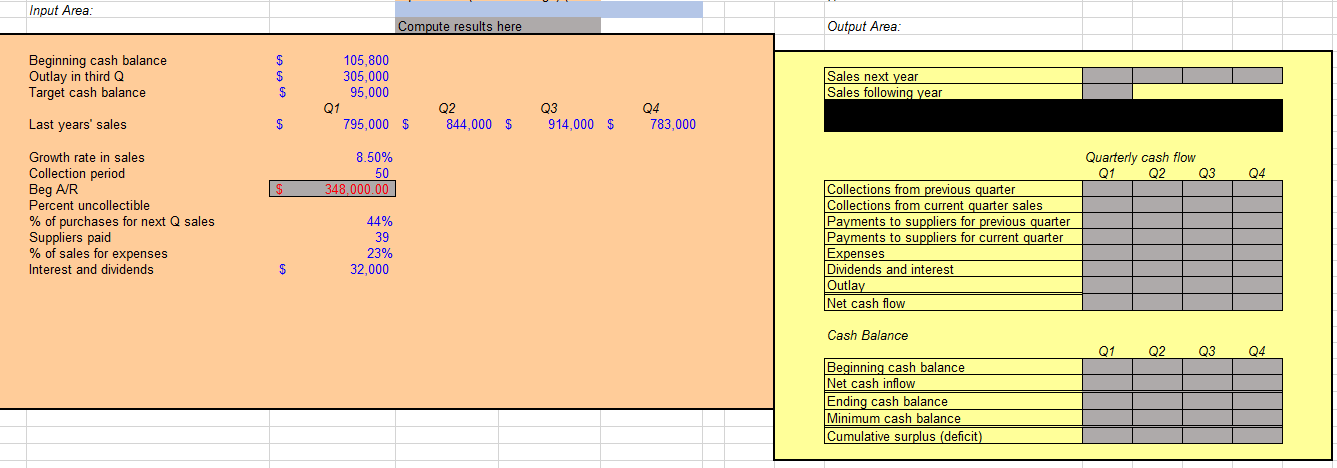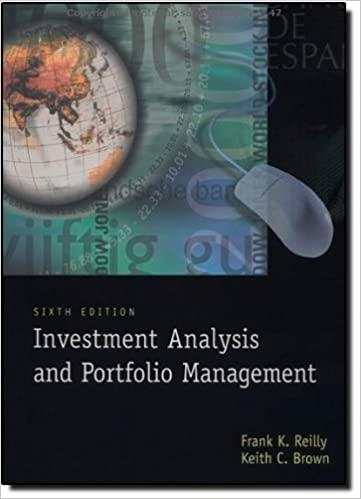Read the following case. Use the numbers from the excel spreadsheet in place of the numbers from the case. Using excel, solve for the output area.



Keafer Manufacturing Working Capital Management You have recently been hired by Keafer Manufacturing to work in its established treasury department. Keafer Manufacturing is a small company that produces highly customized cardboard boxes in a variety of sizes for different purchasers. Adam Keafer, the owner of the company, works primarily in the sales and production areas of the company. Currently, the company basically puts all receivables in one pile and all payables in another, and a part-time bookkeeper periodically comes in and attacks the piles. Because of this disorganized system, the finance area needs work, and that's what you've been brought in to do. The company currently has a cash balance of $210,000 and it plans to purchase new machinery in the third quarter at a cost of $390,000. The purchase of the machinery will be made with cash because of the discount offered for a cash purchase. Adam wants to maintain a minimum cash balance of $135,000 to guard against unforeseen contingencies. All of Keafer's sales to customers and purchases from suppliers are made with credit and no discounts are offered or taken. The company had the following sales each quarter of the year just ended: Q1 Q2 Q3 Q4 Gross sales $1,102,000 $1,141,000 $1,125,000 $1,063,000 After some research and discussions with customers, you're projecting that sales will be 8 percent higher in each quarter next year. Sales for the first quarter of the following year are also expected to grow at 8 percent. You calculate that Keafer currently has an accounts receivable period of 57 days and an accounts receivable balance of $675,000. However, 10 percent of the accounts receivable balance is from a company that has just entered bankruptcy, and it is likely that this portion will never be collected. You've also calculated that Keafer typically orders supplies each quarter in the amount of 50 percent of the next quarter's projected gross sales and suppliers are paid in 53 days, on average. Wages, taxes, and other costs run about 25 percent of gross sales. The company has a quarterly interest payment of $185,000 on its long-term debt. Finally, the company uses a local bank for its short-term financial needs. It currently pays 1.2 percent per quarter on all short-term borrowing and maintains a money market account that pays .5 percent per quarter on all short-term deposits. Adam has asked you to prepare a cash budget and short-term financial plan for the company under the current Page 824 policies. He also has asked you to prepare additional plans based on changes in several inputs. 1. Use the numbers given to complete the cash budget and short-term financial plan. 2. Rework the cash budget and short-term financial plan assuming Keafer changes to a minimum cash balance of $90,000 3. Rework the sales budget assuming an 11 percent growth rate in sales and a 5 percent growth rate in sales. Assume a $135,000 target cash balance. 4. Assuming the company maintains its target cash balance at $135,000, what sales growth rate would result in a zero need for short-term financing? To answer this question, you may need to set up a spreadsheet and use the "Solver function. Input Area Compute results here Output Area: Beginning cash balance Outlay in third Q Target cash balance 105,800 305,000 95,000 Q1 795,000 $ Sales next year Sales following year $ Q2 844,000 $ Q3 914,000 $ Q4 783,000 Last years' sales $ 8.50% 50 348.000.00 Quarterly cash flow Q2 Q3 Q4 S Growth rate in sales Collection period Beg A/R Percent uncollectible % of purchases for next Q sales Suppliers paid % of sales for expenses Interest and dividends 44% 39 23% 32,000 Collections from previous quarter Collections from current quarter sales Payments to suppliers for previous quarter Payments to suppliers for current quarter Expenses Dividends and interest Outlay Net cash flow $ Cash Balance Q1 Q2 Q3 Q4 Beginning cash balance Net cash inflow Ending cash balance Minimum cash balance Cumulative surplus (deficit) Keafer Manufacturing Working Capital Management You have recently been hired by Keafer Manufacturing to work in its established treasury department. Keafer Manufacturing is a small company that produces highly customized cardboard boxes in a variety of sizes for different purchasers. Adam Keafer, the owner of the company, works primarily in the sales and production areas of the company. Currently, the company basically puts all receivables in one pile and all payables in another, and a part-time bookkeeper periodically comes in and attacks the piles. Because of this disorganized system, the finance area needs work, and that's what you've been brought in to do. The company currently has a cash balance of $210,000 and it plans to purchase new machinery in the third quarter at a cost of $390,000. The purchase of the machinery will be made with cash because of the discount offered for a cash purchase. Adam wants to maintain a minimum cash balance of $135,000 to guard against unforeseen contingencies. All of Keafer's sales to customers and purchases from suppliers are made with credit and no discounts are offered or taken. The company had the following sales each quarter of the year just ended: Q1 Q2 Q3 Q4 Gross sales $1,102,000 $1,141,000 $1,125,000 $1,063,000 After some research and discussions with customers, you're projecting that sales will be 8 percent higher in each quarter next year. Sales for the first quarter of the following year are also expected to grow at 8 percent. You calculate that Keafer currently has an accounts receivable period of 57 days and an accounts receivable balance of $675,000. However, 10 percent of the accounts receivable balance is from a company that has just entered bankruptcy, and it is likely that this portion will never be collected. You've also calculated that Keafer typically orders supplies each quarter in the amount of 50 percent of the next quarter's projected gross sales and suppliers are paid in 53 days, on average. Wages, taxes, and other costs run about 25 percent of gross sales. The company has a quarterly interest payment of $185,000 on its long-term debt. Finally, the company uses a local bank for its short-term financial needs. It currently pays 1.2 percent per quarter on all short-term borrowing and maintains a money market account that pays .5 percent per quarter on all short-term deposits. Adam has asked you to prepare a cash budget and short-term financial plan for the company under the current Page 824 policies. He also has asked you to prepare additional plans based on changes in several inputs. 1. Use the numbers given to complete the cash budget and short-term financial plan. 2. Rework the cash budget and short-term financial plan assuming Keafer changes to a minimum cash balance of $90,000 3. Rework the sales budget assuming an 11 percent growth rate in sales and a 5 percent growth rate in sales. Assume a $135,000 target cash balance. 4. Assuming the company maintains its target cash balance at $135,000, what sales growth rate would result in a zero need for short-term financing? To answer this question, you may need to set up a spreadsheet and use the "Solver function. Input Area Compute results here Output Area: Beginning cash balance Outlay in third Q Target cash balance 105,800 305,000 95,000 Q1 795,000 $ Sales next year Sales following year $ Q2 844,000 $ Q3 914,000 $ Q4 783,000 Last years' sales $ 8.50% 50 348.000.00 Quarterly cash flow Q2 Q3 Q4 S Growth rate in sales Collection period Beg A/R Percent uncollectible % of purchases for next Q sales Suppliers paid % of sales for expenses Interest and dividends 44% 39 23% 32,000 Collections from previous quarter Collections from current quarter sales Payments to suppliers for previous quarter Payments to suppliers for current quarter Expenses Dividends and interest Outlay Net cash flow $ Cash Balance Q1 Q2 Q3 Q4 Beginning cash balance Net cash inflow Ending cash balance Minimum cash balance Cumulative surplus (deficit)









